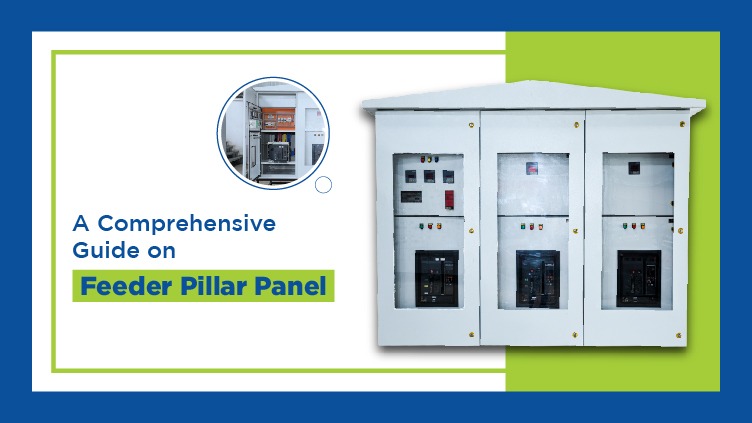A Comprehensive Guide on Feeder Pillar Panel
Within electrical systems, the feeder pillar panel plays a crucial yet often underestimated role in efficiently distributing power. As our electrical networks become more intricate, it’s increasingly important to recognize the significance of feeder pillar panels. This guide intends to shed light on these panels, explaining their function, purpose, and the vital role that electrical panel manufacturers play in crafting them.
What is Feeder Pillar Panel?
A feeder pillar panel, also known as a feeder pillar box, serves as an enclosure housing electrical components essential for power distribution. It acts as an interface between the primary distribution network and secondary circuits, ensuring the safe and efficient transmission of electricity to various destinations.
Components of a Feeder Pillar Panel
Circuit Breakers and Fuses: These devices protect the electrical system from overloads and short circuits by interrupting the flow of electricity when necessary.
Busbars and Terminals: Busbars serve as conductors, distributing electricity from the incoming supply to various outgoing circuits, while terminals facilitate the connection of cables.
Control and Monitoring Equipment: Feeder pillar panels may incorporate control mechanisms and monitoring devices to regulate power flow and supervise the system’s performance.
Enclosure: Designed to safeguard the components from environmental factors and unauthorized access, the enclosure ensures safety and longevity.
Understanding the Functionality of Feeder Pillar Panels
Feeder pillar panels play a pivotal role in electrical distribution networks, enabling the efficient division and direction of power to diverse locations. They serve various functions:
Power Distribution: These panels channel electricity from the primary supply to secondary circuits, enabling controlled and regulated distribution.
Safety Measures: By integrating protective devices such as circuit breakers and fuses, feeder pillar panels prevent electrical hazards like overloads or short circuits, ensuring safety for both the system and users.
Remote Control and Monitoring: Advanced panels incorporate remote control features, allowing operators to monitor and manage the system’s performance from a distance, enhancing efficiency and responsiveness.
Flexibility and Expansion: Feeder pillar panels are designed to accommodate future expansions or modifications in the electrical network, offering flexibility in adapting to evolving power requirements.
Customization and Modularity
Modern feeder pillar panels offer customization options, allowing users to tailor configurations based on specific requirements. Their modular design facilitates easy installation, maintenance, and future expansions without disrupting the entire electrical system.
Remote Monitoring and Control
With the integration of IoT (Internet of Things) technology, feeder pillar panels now offer advanced remote monitoring and control capabilities. Operators can access real-time data, perform diagnostics, and even remotely manage the system, optimizing efficiency and minimizing downtime.
Safety Standards and Compliance
Adherence to safety standards and regulations is paramount in the design and manufacturing of feeder pillar panels. Electrical panel manufacturers ensure compliance with industry standards, such as IEC (International Electrotechnical Commission) or ANSI (American National Standards Institute), ensuring the panels meet safety and performance criteria.
Maintenance and Serviceability
Regular maintenance is crucial to ensure the proper functioning of feeder pillar panels. Manufacturers provide guidelines and support for maintenance practices, making provisions for easy access to components, simplifying troubleshooting, and reducing downtime.
Integration of Smart Technologies
As the world moves towards smart grids and intelligent systems, feeder pillar panels are evolving to incorporate smart technologies. These advancements include predictive maintenance features, self-diagnostic capabilities, and compatibility with smart grid infrastructures for more efficient power management.
Backup and Redundancy
In critical applications where uninterrupted power supply is essential, feeder pillar panels can integrate backup systems like generators or battery banks. This redundancy ensures continuity of power in case of primary supply disruptions.
FAQs
1. Why are Feeder Pillar Panels Essential in Electrical Systems?
Feeder pillar panels act as distribution points, regulating and directing electricity flow while safeguarding against electrical faults. Their role in managing power distribution ensures efficiency, safety, and controlled transmission to various destinations.
2. How do Feeder Pillar Panels Differ from Distribution Boards?
While both feeder pillar panels and distribution boards manage electrical distribution, feeder pillar panels typically operate at higher voltage levels and are often located outdoors or in substations. Distribution boards, on the other hand, are usually indoors and cater to lower voltage circuits within buildings.
3. What Factors Should be Considered While Selecting a Feeder Pillar Panel?
Several aspects influence the selection process, including the intended application, voltage capacity, environmental conditions, and future expansion requirements. Collaborating with reputable electrical panel manufacturers ensures the right choice based on specific needs.
4. Can Feeder Pillar Panels Incorporate Renewable Energy Sources?
Yes, feeder pillar panels can integrate renewable energy sources like solar or wind power. Advanced panels are designed to accommodate diverse energy inputs, allowing seamless integration of sustainable sources into the electrical distribution network.
5. How do Electrical Panel Manufacturers Contribute to Feeder Pillar Panel Quality?
Reputable electrical panel manufacturers play a critical role in ensuring the quality, reliability, and compliance of feeder pillar panels. They leverage expertise in design, engineering, and adherence to safety standards, delivering panels that meet industry specifications and regulatory requirements.
6. How do manufacturers ensure feeder pillar panels withstand diverse environmental conditions while maintaining durability?
Feeder pillar panels are often installed outdoors, subjecting them to various environmental conditions. Manufacturers design these enclosures with materials resistant to corrosion, moisture, dust, and temperature fluctuations to ensure durability and longevity.
The evolution of feeder pillar panels from traditional distribution enclosures to sophisticated, technologically advanced systems reflects the dynamic nature of the electrical industry. Their significance in power distribution networks cannot be understated, as they ensure efficient, safe, and reliable transmission of electricity to various destinations. As technology continues to progress, feeder pillar panels will undoubtedly play a pivotal role in shaping the future of power distribution, catering to diverse applications and emerging energy demands. Collaborating with reputable electrical panel manufacturers remains integral in acquiring high-quality, compliant, and adaptable feeder pillar panels that meet specific operational requirements and ensure long-term performance.

